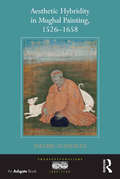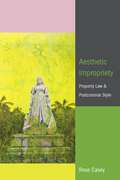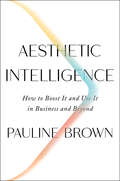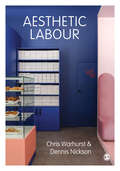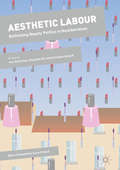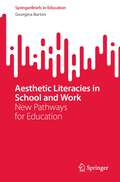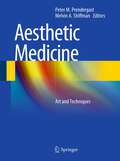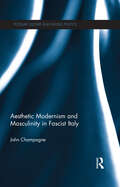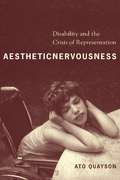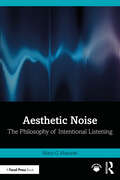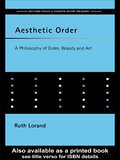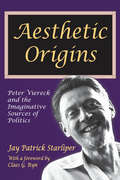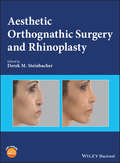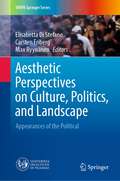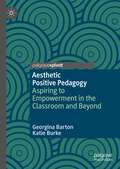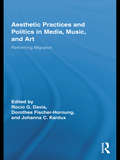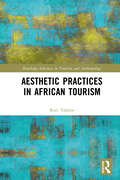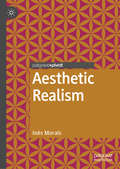- Table View
- List View
Aesthetic Hybridity in Mughal Painting, 1526-1658 (Transculturalisms, 1400-1700)
by Valerie GonzalezThe first specialized critical-aesthetic study to be published on the concept of hybridity in early Mughal painting, this book investigates the workings of the diverse creative forces that led to the formation of a unique Mughal pictorial language. Mughal pictoriality distinguishes itself from the Persianate models through the rationalization of the picture’s conceptual structure and other visual modes of expression involving the aesthetic concept of mimesis. If the stylistic and iconographic results of this transformational process have been well identified and evidenced, their hermeneutic interpretation greatly suffers from the neglect of a methodologically updated investigation of the images’ conceptual underpinning. Valerie Gonzalez addresses this lacuna by exploring the operations of cross-fertilization at the level of imagistic conceptualization resulting from the multifaceted encounter between the local legacy of Indo-Persianate book art, the freshly imported Persian models to Mughal India after 1555 and the influx of European art at the Mughal court in the sixteenth and seventeenth centuries. The author's close examination of the visuality, metaphysical order and aesthetic language of Mughal imagery and portraiture sheds new light on this particular aspect of its aesthetic hybridity, which is usually approached monolithically as a historical phenomenon of cross-cultural interaction. That approach fails to consider specific parameters and features inherent to the artistic practice, such as the differences between doxis and praxis, conceptualization and realization, intentionality and what lies beyond it. By studying the distinct phases and principles of hybridization between the variegated pictorial sources at work in the Mughal creative process at the successive levels of the project/intention, the practice/realization and the result/product, the author deciphers the modalities of appropriation and manipulation of the heterogeneous elements. Her unique
Aesthetic Impropriety: Property Law and Postcolonial Style
by Rose CaseyAcross Africa, Asia, and the Americas, colonial Britain’s property laws are in the process of being transformed. Aesthetic Impropriety analyzes vanguard legal actions and literary innovations to reveal contemporary reforms to property law that are undoing law’s colonial legacies. Casey traces precise legal histories across distinct jurisdictions throughout the anglophone world, revealing the connection between land law and petroleum extraction in the Niger Delta, inheritance and divorce laws and gender inequality in India, intellectual property law and Indigenous dispossession in South Africa, and admiralty law and racialized non-personhood in the English Atlantic. In response to these manifold forms of dispossession, significant reforms are underway, including through common law suits, statutory reform, and proposed changes to legal doctrine. Casey develops the concept of aesthetic impropriety to identify shared structures of thought across legal and literary venues. She shows that writers of poetry and prose are also transforming harmful property laws: in Nigeria, Ben Okri and Chigozie Obioma have articulated symbiotic ecological relationships that are also evidenced in recent actions against petroleum companies; in India, Arundhati Roy’s challenge to divorce laws has preempted similar attempts at reform in Parliament; in South Africa, Zoë Wicomb theorized protections for Indigenous modes of creative production nineteen years before they were signed into law; and in the Americas, M. NourbeSe Philip has proposed a novel method of achieving justice for the one hundred fifty enslaved people who were killed in the 1781 Zong massacre. Aesthetic Impropriety makes a convincing case for literature’s generative capacities and registers the enduring significance of the postcolonial as a necessary framework for understanding globalized inequality in the twenty-first century. By analyzing shared legal and aesthetic transformations, Aesthetic Impropriety argues that law and literature play vital roles in creating anticolonial world orders.
Aesthetic Intelligence: How to Boost It and Use It in Business and Beyond
by Pauline BrownLongtime leader in the luxury goods sector and former Chairman of LVMH Moët Hennessy Louis Vuitton North America reinvents the art and science of brand-building under the rubric of Aesthetic Intelligence. In a world in which people have cheap and easy access to most goods and services, yet crave richer and more meaningful experiences, aesthetics has become a key differentiator for most companies and a critical factor of their success and even their survival. In this groundbreaking book, Pauline Brown, a former leader of the world’s top luxury goods company and a pioneer in identifying the role of aesthetics in business, shows executives, entrepreneurs, and other professionals how to harness the power of the senses to create products, services, and experiences that stand out, resonate with their customers, and create long-term value for their businesses. The power is rooted in Aesthetic Intelligence—or “the other AI,” as Brown refers to it. Aesthetic Intelligence can be learned. Indeed, people are born with far more capacity than they use, but even those that are naturally gifted must continue to refine their skills, lest their aesthetic advantage atrophy. Through a combination of storytelling and practical advice, the author shows how aesthetic intelligence creates business value and how executives, entrepreneurs and others can boost their own AI and successfully apply it to business. Brown offers research, strategies and practical exercises focused on four essential AI skills. Aesthetic Intelligence provides a crucial roadmap to help business leaders build their businesses in their own authentic and distinctive way. Aesthetic Intelligence is about creating delight, lifting the human spirit, and rousing the imagination through sensorial experiences.
Aesthetic Labour
by Dennis Nickson Chris WarhurstThis accessible and exciting new text looks at the implications of aesthetic labour for work and employment by contextualizing debates and offering a critical approach. The origins of aesthetic labour are explored, as well as the relevant theories from business and management, and sociology. Coverage includes key topics such as: corporate strategy; recruitment and selection practices; and discrimination. Key features include: - a range of case studies from across different types of organizations and popular culture - the exploration of topics such as branding, ′lookism′, ′dressing for success′ and cosmetic surgery - suggestions for further reading.
Aesthetic Labour
by Dennis Nickson Chris WarhurstThis accessible and exciting new text looks at the implications of aesthetic labour for work and employment by contextualizing debates and offering a critical approach. The origins of aesthetic labour are explored, as well as the relevant theories from business and management, and sociology. Coverage includes key topics such as: corporate strategy; recruitment and selection practices; and discrimination. Key features include: - a range of case studies from across different types of organizations and popular culture - the exploration of topics such as branding, ′lookism′, ′dressing for success′ and cosmetic surgery - suggestions for further reading.
Aesthetic Labour: Rethinking Beauty Politics in Neoliberalism (Dynamics of Virtual Work)
by Ana Sofia Elias Rosalind Gill Christina ScharffThis volume approaches questions about gender and the politics of appearance from a new perspective by developing the notion of aesthetic labour. Bringing together feminist writing regarding the 'beauty myth' with recent scholarship about new forms of work, the book suggests that in this moment of ubiquitous photography, social media, and 360 degree surveillance, women are increasingly required to be 'aesthetic entrepreneurs', maintaining a constant state of vigilance about their appearance. The collection shows that this work is not just on the surface of bodies, but requires a transformation of subjectivity itself, characterised by notions of personal choice, risk-taking, self-management, and individual responsibility. The book includes analyses of online media, beauty service work, female genital cosmetic surgery, academic fashion, self-help literature and the seduction community, from a range of countries. Discussing beauty politics, postfeminism, neoliberalism, labour and subjectivity, the book will be of interest to scholars and students with an interest in Gender, Media Studies, Cultural studies, Sociology, Social Psychology and Management Studies. "This highly engaging, smart, and wide-ranging collection analyzes how, under the self-governing mandates of neoliberalism, the demands that girls and women regulate and control their bodies and appearance have escalated to new, unforgiving levels. A special strength of the book is its emphasis on the rise of 'aesthetic labour' as a global, transnational and ever-colonizing phenomenon that seeks to sweep up women of all races, ages and locales into its disciplinary grip. Highly recommended. " -Susan J Douglas, University of Michigan, USA -Melissa Gregg, Intel Corporation, USA "This book incisively conceptualizes how neo-liberalist and postfeminist tendencies are ramping up pressures for glamour, aesthetic, fashion, and body work in the general public. In a moment when YouTube 'makeup how to' videos receive millions of hits; what to wear and how to wear it blogs clock massive followings; and staying 'on brand' is sold to us as the key to personal and financial success, 'aesthetic entrepreneurship' is bound to become a go-to concept for anyone seeking to understand the profound shifts shaping labor and life in the 21st century. " -Elizabeth Wissinger, City University of New York, USA
Aesthetic Literacies in School and Work: New Pathways for Education (SpringerBriefs in Education)
by Georgina BartonThis book argues the importance of aesthetic literacies in learning and teaching in schools for future work. The study of aesthetics is critical in today’s learning, due to the increasingly complex ways in which we communicate meaning, such as through the presentation of texts and objects. The book provides educators, pre-service teachers, and students an in-depth understanding of aesthetic literacies in innovative spaces, including in philosophical literature, environmental spaces, curricula and classrooms. Using various theoretical frames from both the arts and literacy fields, this book shares relevant pedagogies, theorisations and contexts where aesthetic literacies are at the core of learning. It emphasises how improved knowledge of aesthetics and quality experiences in beauty are vital in aiding students and young children develop the necessary resilience and tolerance needed in today’s uncertain world.
Aesthetic Medicine: Art and Techniques
by Melvin A. Shiffman Peter M. PrendergastThe Aesthetic Medicine: Art and Techniques provides step-by-step instructions in the procedures and techniques commonly employed in aesthetic medicine. The book is divided into four parts, the first two of which offer an introduction to aesthetic medicine and discuss preoperative assessment and treatment. Detailed guidance is then given on a wide range of cutaneous procedures, including the use of botulinum toxins, dermabrasion and microdermabrasion, cryotherapy, chemical peel skin resurfacing, laser treatments, mesotherapy, sclerotherapy, capacitive radiofrequency treatment, and the use of dermarollers. The final part of the book is devoted to techniques employed in shaping the face and body, such as breast and facial augmentation, penile enhancement, liposuction, and management of hair loss or excess hair. All procedures are depicted with the aid of numerous high-quality illustrations and color photographs. This book will serve as an excellent guide for both beginners and experienced practitioners.
Aesthetic Modernism and Masculinity in Fascist Italy (Popular Culture and World Politics)
by John ChampagneAesthetic Modernism and Masculinity in Fascist Italy is an interdisciplinary historical re-reading of a series of representative texts that complicate our current understanding of the portrayal of masculinity in the Italian fascist era. Examining paintings, films, music and literature in light of some of the ideological and material contradictions that animated the regime, it argues that fascist masculinity was itself highly contradictory. It brings to the fore works that have tended to be under-studied, and argues that, while fascist inclusive strategies of patronage worked to bind artists to the regime, an official policy of non-interference may inadvertently have opened up a space whereby the arts expressed a more complicated and contestatory view of masculinity than the one proffered by kitsch photos of a bare-chested Mussolini skiing. Champagne seeks to evaluate how the aesthetic analysis of the artefacts explored offer a more sophisticated and nuanced understanding of what world politics is, what is at stake when something – like masculinity – is rendered as being an element of world politics, and how such an understanding differs from more orthodox ‘cultural’ analyses common to international relations. Providing a significant contribution to understandings of representations of masculinities in modernist art, this work will be of great interest to students and scholars of gender studies, queer studies, political science, Italian studies and art history.
Aesthetic Nervousness: Disability and the Crisis of Representation
by Ato QuaysonFocusing primarily on the work of Samuel Beckett, Toni Morrison, Wole Soyinka, and J. M. Coetzee, Ato Quayson launches a thoroughly cross-cultural, interdisciplinary study of the representation of physical disability. Quayson suggests that the subliminal unease and moral panic invoked by the disabled is refracted within the structures of literature and literary discourse itself, a crisis he terms "aesthetic nervousness." The disabled reminds the able-bodied that the body is provisional and temporary and that normality is wrapped up in certain social frameworks. Quayson expands his argument by turning to Greek and Yoruba writings, African American and postcolonial literature, depictions of deformed characters in early modern England and the plays of Shakespeare, and children's films, among other texts. He considers how disability affects interpersonal relationships and forces the character and the reader to take an ethical standpoint, much like representations of violence, pain, and the sacred. The disabled are also used to represent social suffering, inadvertently obscuring their true hardships.
Aesthetic Noise: The Philosophy of Intentional Listening
by Mary G. MazurekAesthetic Noise: The Philosophy of Intentional Listening considers the complex nature of noise within the framework of philosophical filtering, examining how, if noise is engaged with aesthetically, it can produce profound experiences and understandings.Applying the philosophies of Edmund Burke, Martin Heidegger, Jacque Derrida, and Julia Kristeva to works by Luigi Russolo, John Cage, Steve Reich, Alison Knowles, Annea Lockwood, Alyce Santoro, and Sunn O))), this book explores noise as an art material, and ultimately how it can become a tool for activism and expanded creative possibilities. It demonstrates that, by engaging multiple philosophies in concert, the value of aesthetic noise is amplified, thus allowing the listener to better appreciate noise and its possibilities.Providing greater insights into noise as an aesthetic material, Aesthetic Noise will be of interest to researchers and students of sound studies, philosophy, and sound art, as well as sound designers, artists, musicians, and composers.
Aesthetic Order: A Philosophy of Order, Beauty and Art (Routledge Studies in Twentieth-Century Philosophy)
by Ruth LorandAesthetic Order challenges contemporary theories of aesthetics, offering the idea of beauty as quantitative yet different from the traditional discursive order. It will be of importance to all interested in aesthetic theory.
Aesthetic Origins: Peter Viereck and the Imaginative Sources of Politics
by Claes G. Ryn Jay Patrick StarliperWhile it is gaining in academic prominence, discussion of the imagination is too often neglected. Society is dangerously unaware of the intimate relationship between culture and politics, ethics and aesthetics. Challenging this, Jay Patrick Starliper examines the imagination through the lens of the work of Peter Viereck and other likeminded thinkers. The result is a philosophical deconstruction that demonstrates why books are bullets.In 1941, before Nazi barbarism was public knowledge, a young Peter Viereck published Metapolitics: From Wagner and the German Romantics to Hitler. In it, Viereck attacked the diabolical spiritual foundations of National Socialism. He made the ostensibly absurd claim that a certain shade of romanticism was the ethical foundation of a German revolt against decency. According to Viereck, Nazism was the culmination of over a century and a half of bad culture, the result of an idyllic imagination. Starliper warns that the same diseased imagination that culminated in gas chambers and guillotines is subtly affecting the way millions of people view the world today and that, without the inspiration of an elevated aesthetic, civilization will not survive.In the spirit of Edmund Burke and Irving Babbitt, Viereck's insight into the ethical and political force of aesthetics provides a much needed critique of contemporary civilization.
Aesthetic Orthognathic Surgery and Rhinoplasty
by Derek M. SteinbacherComprehensive in scope, Aesthetic Orthognathic Surgery and Rhinoplasty presents orthognathic surgery from an aesthetic perspective, encompassing analysis, diagnosis, treatment, 3D virtual planning, and adjunctive procedures. Easily accessible clinical information presented in a concise and approachable format Well-illustrated throughout with more than 1,000 clinical photographs Includes access to a companion website with videos of surgical procedures
Aesthetic Perceptions of Urban Environments (Interventions)
by Arundhati VirmaniTo what extent do urban dwellers relate to their lived and imagined environment through aesthetic perceptions, and aspirations? This book approaches experiences of urban aesthetics not as an established framework, defined by imposed norms or legislations, but as the result of a continuous reflexive and proactive gaze, a complex and deep engagement of the mind, body and sensibilities. It uses empirical studies ranging from China, India to Western Europe. Three axes are privileged. The first considers urban everyday aesthetic experiences in the long-term as a historical production, from medieval Italy to a future imagined by science fiction. The second examines the impact of aestheticizing everyday material realities in neighbourhoods, and the tensions and conflicts these engender around urban commons. Finally, the third axis considers these relationships as aesthetic inequalities, exacerbated in a new age of urban development. The book combines local and transnational scales with an interdisciplinary approach, bringing together historians, sociologists, cultural geographers, anthropologists, architects, and contemporary art curators. They illustrate the importance of combining different social science methods and functional perspectives to study such complex social and cultural realities as cities. This book will be of interest to students, scholars and practitioners of humanities and social sciences, cultural and urban studies, architecture and political geography.
Aesthetic Perspectives on Culture, Politics, and Landscape: Appearances of the Political (UNIPA Springer Series)
by Max Ryynänen Elisabetta Di Stefano Carsten FribergThis book investigates how we are involved in politically informed structures and how they appear to us. Following different approaches in contemporary aesthetics and cultural philosophy, such as everyday aesthetics, atmosphere and aestheticization, the contributions explore how embedded powers in politics, education, democracy, and landscape are analyzed through aesthetics.
Aesthetic Plastic Surgery of the Abdomen
by Melvin A. Shiffman Alberto Di GiuseppeThis comprehensive book covers anatomy, recent techniques, postoperative care, possible complications and outcomes in aesthetic surgery of the abdomen. The extensive section on aesthetic procedures includes many important innovations in abdominoplasty. Detailed consideration is also given to the various potential complications, with guidance on their prevention, diagnosis, and management. The book is written by acknowledged experts in the topics on which they write. It will be of value for residents and fellows and more experienced surgeons in the fields of plastic surgery, general surgery, cosmetic surgery and general surgery.
Aesthetic Pleasure in Twentieth-Century Women's Food Writing: The Innovative Appetites of M.F.K. Fisher, Alice B. Toklas, and Elizabeth David (Routledge Studies in Twentieth-Century Literature)
by Alice McLeanThis book explores the aesthetic pleasures of eating and writing in the lives of M. F. K. Fisher (1908-1992), Alice B. Toklas (1877-1967), and Elizabeth David (1913-1992). Growing up during a time when women's food writing was largely limited to the domestic cookbook, which helped to codify the guidelines of middle class domesticity, Fisher, Toklas, and David claimed the pleasures of gastronomy previously reserved for men. Articulating a language through which female desire is artfully and publicly sated, Fisher, Toklas, and David expanded women’s food writing beyond the domestic realm by pioneering forms of self-expression that celebrate female appetite for pleasure and for culinary adventure. In so doing, they illuminate the power of genre-bending food writing to transgress and reconfigure conventional gender ideologies. For these women, food encouraged a sensory engagement with their environment and a physical receptivity toward pleasure that engendered their creative aesthetic.
Aesthetic Poetry
by Walter PaterTHE "aesthetic" poetry is neither a mere reproduction of Greek or medieval poetry, nor only an idealisation of modern life and sentiment. <P> <P> The atmosphere on which its effect depends belongs to no simple form of poetry, no actual form of life. Greek poetry, medieval or modern poetry, projects, above the realities of its time, a world in which the forms of things are transfigured. Of that transfigured world this new poetry takes possession, and sublimates beyond it another still fainter and more spectral, which is literally an artificial or "earthly paradise."
Aesthetic Positive Pedagogy: Aspiring to Empowerment in the Classroom and Beyond
by Georgina Barton Katie BurkeThis book introduces and explores a new pedagogical approach, Aesthetic Positive Pedagogy (APP), for teachers and students in a variety of educational contexts. The book is built on the need for educational institutions and communities to seriously consider a strong positive approach to learning and teaching, ultimately leading to a better world. Based on pre-existing philosophies such as positive pedagogy and critical pedagogy, APP encourages teachers to carefully consider their language use as well as other modal resources in the classroom. Using aesthetic experience as a core to learning, teachers can embed an approach to learning and teaching that supports wellbeing and resilience as well as caring and compassionate citizenship in their students. The authors outline what an APP approach to learning and teaching looks, feels and sounds like in different educational contexts such as in schools and higher education, and explore how it might be implemented in face-to-face as well as online learning. The book’s findings will apply to postgraduate students and academics in education and the creative arts, as well as teachers and leaders in schools.
Aesthetic Practices and Politics in Media, Music, and Art: Performing Migration
by Rocío G. DavisThis volume analyzes innovative forms of media and music (art installations, television commercials, photography, films, songs, telenovelas) to examine the performance of migration in contemporary culture. Though migration studies and media studies are ostensibly different fields, this transnational collection of essays addresses how their interconnection has shaped our understanding of the paradigms through which we think about migration, ethnicity, nation, and the transnational. Cultural representations intervene in collective beliefs. Art and media clearly influence the ways the experience of migration is articulated and recalled, intervening in individual perceptions as well as public policy. To understand the connection between migration and diverse media, the authors examine how migration is represented in film, television, music, and art, but also how media shape the ways in which host country and homeland are imagined. Among the topics considered are new mediated forms for representing migration, widening the perspective on the ways these representations may be analyzed; readings of enactments of memory in trans- and inter-disciplinary ways; and discussions of globalization and transnationalism, inviting us to rethink traditional borders in respect to migration, nation states, as well as disciplines.
Aesthetic Practices in African Tourism (Routledge Advances in Tourism and Anthropology)
by Ruti TalmorAesthetic Practices in African Tourism explores "Rastahood", a community, youth culture, and new tourist art form created by young men on the margins of the Ghanaian economy as they came of age at the turn of the millennium. This book focuses on art, music, and affective experience created within tourism contexts, which enabled young men without educational or class capital to achieve mobility through work with foreigners, transforming the temporal horizon by expanding the geographic one. It traces the path that led young men down the path to Rastahood and investigates how they created an art form in, and of, a particular place and then used it to propel themselves far beyond its confines. The book ends with a leap forward into the present, out of Ghana, and beyond Rastahood, as men, now in middle age, look back upon the path that Rastahood created. It explores the social effects of neoliberal capitalism, specifically the rise of neoliberal subjectivities, collectivities, and socialities. The book will be of interest to researchers in the fields of anthropology, cultural studies, tourism, art, African and Africana Studies, popular culture; gender studies; migration; youth studies and those interested in African cities.
Aesthetic Procedures: Nurse Practitioner's Guide to Cosmetic Dermatology
by Beth HaneyThis book is a resource that offers guidance to nurses who are experienced or novice aesthetic practitioners and would like to improve their aesthetic practice and enhance patient safety and satisfaction. This textbook reviews skin structure and anatomy, what happens as facial structures age, the effects of aging coupled with environmental exposures, pharmacology of medications used in aesthetics, light-based device properties, patient selection, and benefits of treatments. In addition, it includes suggestions on how to communicate with patients to achieve successful outcomes. Aesthetic Procedures: Nurse Practitioner's Guide to Cosmetic Dermatology provides practitioners a one-source resource to attain more in-depth learning about cosmetic dermatology. Although there are several texts on individual aspects of aesthetic medicine, there is no all-inclusive book for nurses. This book affords the primary care practitioner the opportunity to add minimally invasive cosmetic dermatology procedures to their practice and perform the treatments safely, efficiently and effectively while avoiding common mistakes and minimizing complication risks. Education is paramount in creating a safe patient environment and as more clinicians turn to aesthetics to augment their practice, this book will be a valuable resource for nurses and practitioners all over the world.
Aesthetic Procedures: Nurse Practitioner's Guide to Cosmetic Dermatology
by Beth HaneyThis second edition is a resource that offers guidance to advanced practice providers who are experienced or novice aesthetic practitioners and would like to improve their aesthetic practice and enhance patient safety and satisfaction. This new book reviews skin structure and anatomy, what happens as facial structures age, the effects of aging coupled with environmental exposures, pharmacology of medications used in aesthetics, light-based device properties, patient selection, danger zones, complications, new treatments, and benefits of treatments. In addition, it includes suggestions on how to communicate with patients to achieve successful outcomes. Aesthetic Procedures: Nurse Practitioner's Guide to Cosmetic Dermatology provides practitioners a one-source resource to attain more in-depth learning about cosmetic dermatology. Although there are several texts on individual aspects of aesthetic medicine, there is no all-inclusive book for advanced practice providers. This book also affords the primary care practitioner the opportunity to add minimally invasive cosmetic dermatology procedures to their practice and perform the treatments safely, efficiently and effectively while avoiding common mistakes and minimizing complication risks. Education and hands-on practice and training are paramount in creating a safe patient environment and as more clinicians turn to aesthetics to augment their practice, this book will be a valuable resource for practitioners all over the world.
Aesthetic Realism
by Inês MoraisThis compelling book defends realism concerning the aesthetic—in particular, concerning the aesthetic properties of works of art (including works of literature). Morais lucidly argues that art criticism, when referring to aesthetic properties, is referring not ultimately to the critic’s subjective reactions, but to genuine properties of the works. With a focus on contemporary discussion conducted in the analytic tradition, as well as on arguments by Hume and Kant, this book characterizes the debate in aesthetics and the philosophy of art concerning aesthetic realism, examining attacks on the objectivity of values, the ‘autonomy thesis’, and Hume’s sentimentalism. Considering and defusing scepticism concerning the significance of the ontological debate about aesthetic realism, Morais discusses two powerful attacks on aesthetic realism before defending the doctrine against them and providing a positive realist account of aesthetic properties.
